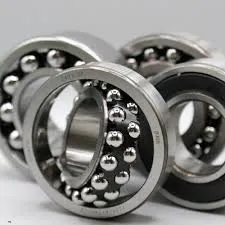
Dec . 11, 2024 10:43 Back to list
Comparison of Spherical and Cylindrical Roller Bearings in Industrial Applications
Spherical Roller Bearings vs. Cylindrical Roller Bearings
When it comes to the world of rolling element bearings, two of the most commonly utilized types are spherical roller bearings and cylindrical roller bearings. Each type has its unique characteristics, advantages, and applications, making them suitable for different conditions in mechanical systems. Understanding the differences between these two bearing types is crucial for engineers and technicians when selecting the right bearing for their specific application.
Design and Structure
Spherical roller bearings are designed with two rows of symmetrical spherical rollers that can accommodate misalignment between the inner and outer rings. This design allows the bearing to effectively handle radial loads and some axial loads in both directions. Spherical roller bearings feature a concave outer raceway and round rollers, which provide a self-aligning capability that is particularly useful in applications where shaft deflections or mounting errors may occur.
On the other hand, cylindrical roller bearings consist of cylindrical rollers that are arranged parallel to the axis of the bearing. These bearings are designed to accommodate high radial loads and have a relatively high speed capability. While they can handle some axial loads, they typically do not accommodate misalignment as effectively as spherical roller bearings due to their rigid design.
Load Capacity and Performance
When it comes to load capacity, spherical roller bearings excel in applications that involve complex loading conditions. Their ability to handle both radial and axial loads while accommodating misalignment makes them ideal for heavy machinery, such as construction equipment and mining applications. These bearings can carry greater loads due to their larger contact area with the raceway.
Cylindrical roller bearings, meanwhile, are known for their high radial load capacity. The contact area between the rollers and the raceways is higher than that of spherical roller bearings, allowing them to support heavier loads in a more compact design. Consequently, cylindrical roller bearings are commonly used in applications such as electric motors, gearboxes, and industrial machinery where high speeds and reduced friction are vital.
spherical roller bearing vs cylindrical roller bearing

Speed and Friction
Both types of bearings are designed to operate under specific speed conditions, but cylindrical roller bearings generally have the advantage when it comes to high-speed operation. The streamlined design of the cylindrical rollers minimizes friction and heat generation, enabling these bearings to perform efficiently at elevated speeds.
Conversely, spherical roller bearings may generate slightly more friction due to their spherical roller geometry and the potential for misalignment. However, newer designs and materials have improved the performance of spherical roller bearings, making them more versatile in various applications.
Applications
The choice between spherical and cylindrical roller bearings often comes down to the specific requirements of the application. Spherical roller bearings are typically preferred in applications that involve shock loads or significant misalignment, such as in heavy-duty industrial machines, mining equipment, and certain automotive applications.
Cylindrical roller bearings find their place in environments where high radial loads and speeds are prevalent, such as in electric motors, pumps, and high-speed spindles. Their robust design and ability to handle heavy loads in a compact form make them ideal for many engineering applications.
Conclusion
In summary, both spherical roller bearings and cylindrical roller bearings have unique properties and advantages that make them suitable for various applications. While spherical roller bearings are ideal for handling misalignment and complex loading conditions, cylindrical roller bearings excel in high-speed applications and provide higher radial load capacities. By understanding the differences and considering the specific operational requirements, engineers can make informed decisions when selecting the appropriate bearing type for their needs.
Latest news
-
Precision Thrust Ball Bearings: Expert Axial Load Solutions
NewsSep.01,2025
-
Durable Greenhouse Pillow Block Bearings for Reliable Ventilation
NewsAug.31,2025
-
Spherical Roller Bearings Applications: Heavy Duty, Self-Aligning
NewsAug.30,2025
-
Premium Deep Groove Ball Bearings | High Speed & Reliability
NewsAug.29,2025
-
Durable Scaffolding Clamps - Secure & Reliable Tube Connectors
NewsAug.28,2025
-
Common Failures in Thrust Ball Bearings and Solutions
NewsAug.22,2025
